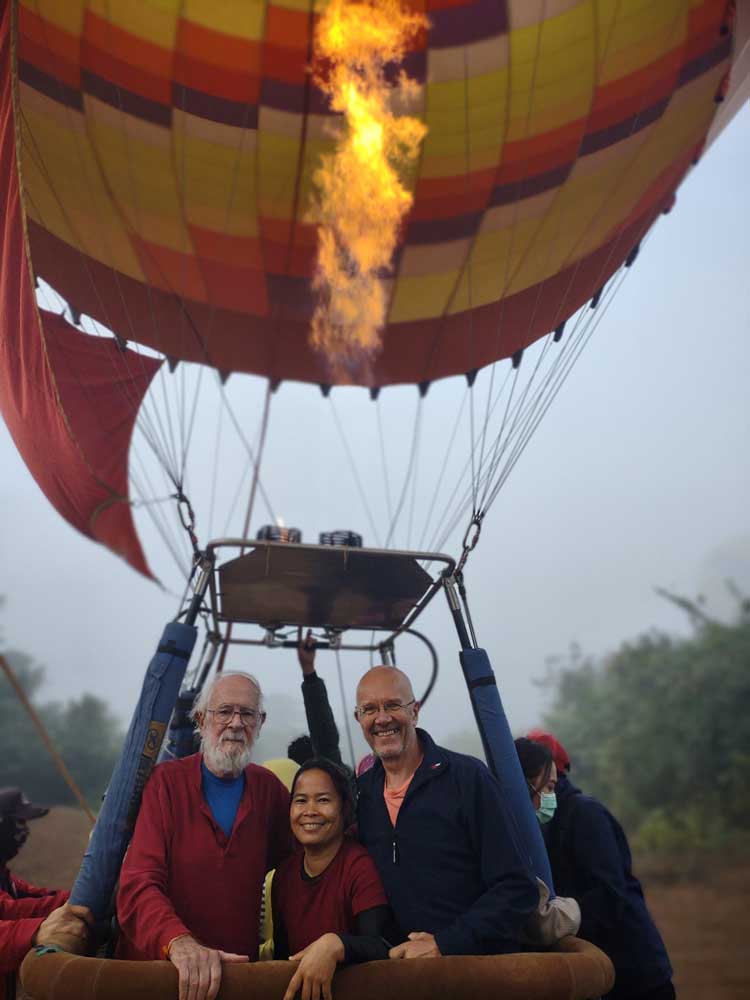Raymond retiree pursues peace mission
Published 7:06 am Tuesday, January 2, 2024

- “It was the funnest thing I’ve ever done in my life,” noted Michael Spencer, pictured left, taking a balloon ride during his stay in Southeast Asia at the instigation of a British friend just so he could cross it off his bucket list.
Michael Spencer’s life could be the basis for a guide to socially engaged retirement.
The 81-year-old Raymond resident has traveled — and lived — in several countries, a wanderlust inspired by his professional science background and his desire to make a difference.
He has friends of many nationalities all over the globe. “All of you are the frosting on my cake of life experiences,” he noted in an online greeting.
The new year finds him in Laos, teaching English to students spanning varied ages, inspired by his devout belief that the United States needs to give back to the Southeast Asian country it ravaged decades ago.
“The Lao are the kindest, most loveliest people I’ve ever met,” said Spencer, who has his own great grandchildren but has also bonded with an “honorary daughter and grandson” and continues to expand his family.
‘Odyssey’
Spencer graduated from Willapa Valley High School in 1960 and Washington State University in 1964. He initially earned a full-ride scholarship to begin a Ph.D. in biochemistry at Duke University, but soon returned to Seattle to enroll in a master’s in business program at the University of Washington.
Neither suited him, and that triggered what he fondly describes as “an overseas odyssey” that ran from 1966 to 1982.
His adventures included two-year stints doing medical research in Copenhagen, Denmark, in British Columbia, where he taught science, and in the Netherlands, serving in Amsterdam as an editor for the Federation of European Biochemical Societies.
Limnology, the study of water and ecosystems, then took him to New Zealand for eight years, with a year studying the science at a technical university in Germany.
When he returned to the United States, he worked 24 years at the Washington State Department of Ecology, conducting assessments of hazardous waste sites.
More Information
More Information
Laos
Full name: Lao People’s Democratic Republic
Population: 7,749,595 (2022)
Land area: 91,400 square miles (slightly smaller than Oregon).
History: Kingdom established, 1353; monarchy abolished 1975
Raymond resident Michael Spencer posted this note after his first visit. “I have found the Lao to be the most resilient people I have ever met. … The humility and kindness exhibited by these people, in spite of their apparent day-to-day very frugal existence, is not only staggering, but admirable — a truly positive expression of the human spirit to not only survive, but to endure.”
‘Wrong place’
In retirement, he found satisfaction as part of an international volunteer program, returning to New Zealand in 2016 to assist the Maoris with freshwater habitat projects and three one-month stints in each of the years that followed helping run a charity food kitchen in Ho Chi Minh City, Vietnam. “We served up at least 350 very cheap, but very good, meals a day for very low-income people,” he said.
His link with Laos dates to 2015, where he traveled to volunteer outside the capital of Vientiane. He was inspired, in part, by immigrant families in Raymond and his favorite movie, “Gran Torino,” Clint Eastwood’s 2008 story highlighting the Hmong, one of the largest minority groups from Laos.
“I already knew about all the great Lao refugees who settled in my small hometown … after I had moved back there in December 1982. But I never, as the vast majority of Americans, knew about the ‘secret’ war the U.S. had in Laos where we bombed the total (expletive) out of the country from 1964-1973 just because it happened to be in the wrong place at the wrong time.”
A sad legacy
While many details were not fully reported at the time, modern historians have chronicled how U.S. forces sought to disrupt the transportation of materials to supply North Vietnamese forces through neighboring Laos along what was nicknamed the Ho Chi Minh Trail.
That led to an estimated 60,000 deaths in the neutral country over a 10-year period; the U.S. reportedly dropped 2 million tons of bombs. Craters are used as fishponds and for agricultural irrigation systems.
‘The legacy of all that bombing lives on today.’
Michael Spencer, describing Laos
Spencer’s ire over what happened to Laos is palpable.
“Sadly, my government’s and military’s thinking was destroy it! They tried. Luckily, they never succeeded 100% but, sadly, the legacy of all that bombing lives on today.”
In addition, Spencer believes that when the U.S. was defeated in Vietnam, it abandoned those in Laos who had supported it; thousands fled the turmoil that followed, with some families settling in Raymond.
“So I committed myself since then, minus the covid years, to do what I could to make the lives of people in Laos and Vietnam better, incrementally, in ways that I could,” Spencer noted.
His devotion to “giving back” is inspired, in part, by repeated reading of “No Bars to Manhood” by Daniel Berrigan and “Prison Journals of a Priest Revolutionary” by his brother Philip Berrigan, two Catholic priests imprisoned in 1968 for burning draft cards and protesting nuclear armaments.
Motivated to learn
His current project is five weeks teaching English to students who range from Buddhist monks to children as young as eight.
Their fluency varies significantly. “I have a class of 10- to 16-year-olds barely speaking or understanding English to a class or two of 8- to 18-year-olds who are a dream to teach,” he said. “It is a teacher’s dream job when their students are 100% motivated and committed to learning.”
He delights in posting details of his experiences on his Facebook page, where his readers learn about food choices like pork laab salads and jeow bong chili paste, the visitors he encounters from Poland and Scandinavia, and inland weather which rises to 91 degrees in the country’s former capital city.
“The local economy of Luang Prabang is pretty much based on tourism,” he said. “The best employment opportunities are working in restaurants, hotels and shops where understanding and speaking passable English is a must.”
There is a deeper mission, too.
“I also especially want to see the young girls and women enable themselves to have the freedom to make better life choices,” he said. “The classes are about 75% female.”
The reward is evident. “I was asked last night if I was enjoying my experience over here. I replied, ‘If I could possibly enjoy it any more, I would have to be twins!’”









